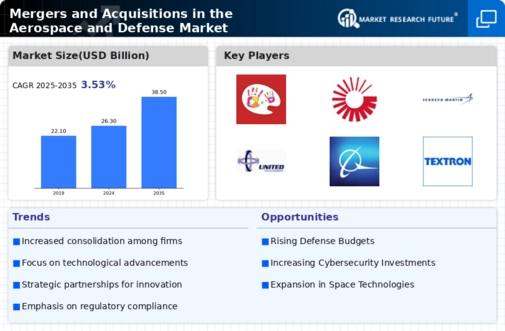The Global Mergers and Acquisitions in the Aerospace and Defense Market has shown a dynamic landscape characterized by strategic financial transactions, with many companies aiming to enhance their capabilities, access new technologies, and broaden their market reach.
The competition remains intense as major players look to capitalize on synergies from acquired assets while addressing the challenges that accompany integrating diverse corporate cultures and operational systems.
As technological advancements continue to reshape the aerospace and defense sectors, mergers and acquisitions serve as a critical strategy for entities aiming to maintain relevance and foster innovation.
Key trends indicate a growing interest in cybersecurity, unmanned systems, and space exploration technologies, driving firms to seek out complementary businesses that can provide a competitive edge through enhanced product offerings or expanded geographical presence.
Leonardo stands out in the Global Mergers and Acquisitions in the Aerospace and Defense Market, leveraging its strong portfolio and strategic focus on innovation. The company has made significant investments in advanced technologies, including integrated systems, training solutions, and cybersecurity, which reinforce its competitive positioning.
Leonardo's strengths lie in its robust research and development capabilities that empower it to respond to emerging market demands and warfighter requirements effectively. This dedication to technological advancement, combined with a well-established reputation for quality and reliability in both the aerospace and defense sectors, bolsters its attractiveness in potential mergers and acquisitions.
Furthermore, its ability to foster collaborative partnerships enhances its market presence, providing it with unique opportunities to explore synergies with other industry players. Airbus commands a formidable position in the Global Mergers and Acquisitions in the Aerospace and Defense Market, driven by its extensive experience and innovative solutions across both commercial and military aerospace sectors.
The company excels in leveraging its advanced engineering capabilities and extensive supply chain that promotes efficiency and scalability. Airbus has strategically engaged in acquisitions to bolster its defense portfolio, focusing on developing next-generation technologies for air mobility, satellite communications, and space exploration.
This approach has enabled Airbus to enhance its market footprint while optimizing operational efficiencies. Moreover, Airbus's commitment to sustainability within the aerospace industry has positioned it favorably as increasingly environmentally conscious consumers and governments look for ways to reduce their carbon footprints.
With a healthy pipeline of new projects and a proactive approach to mergers and acquisitions, Airbus is well-equipped to navigate the challenges and opportunities that arise within the competitive landscape of the aerospace and defense market.


















Leave a Comment